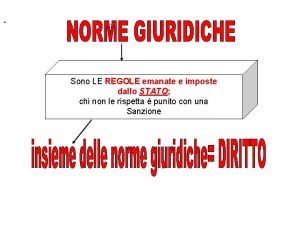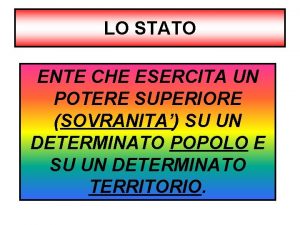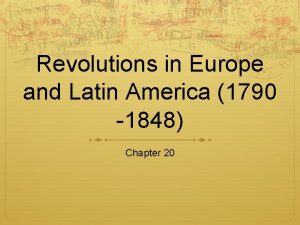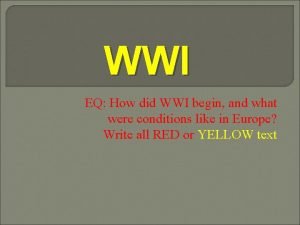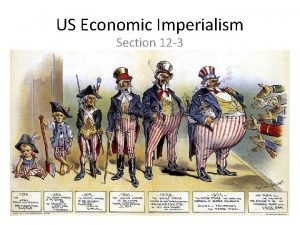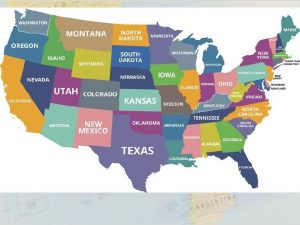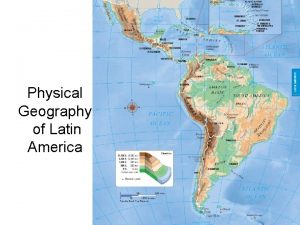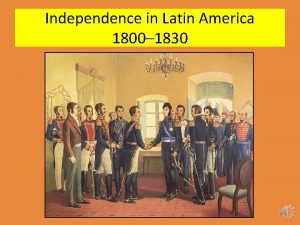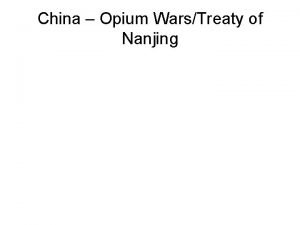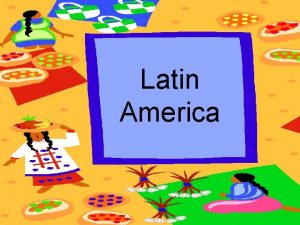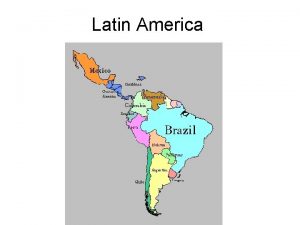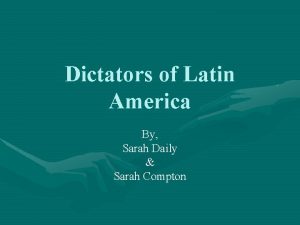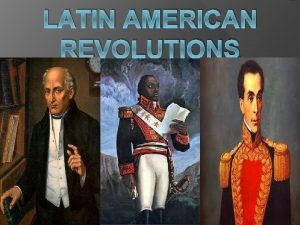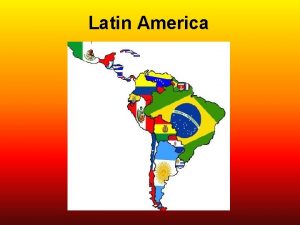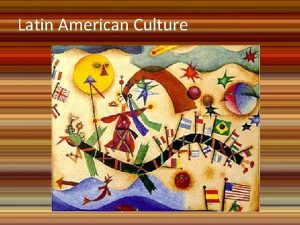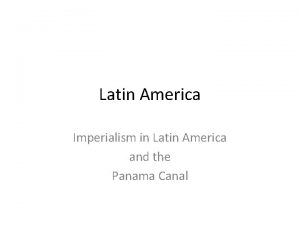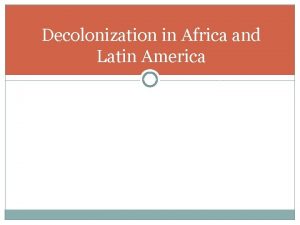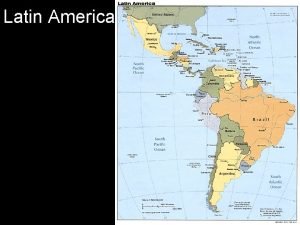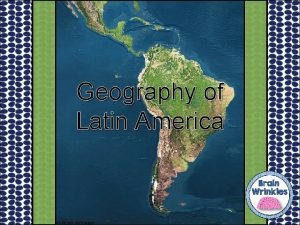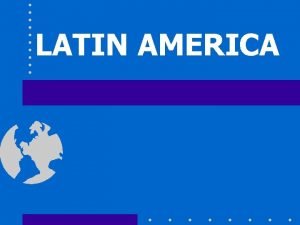Canada and Latin America in WWI Sarah Dallo
























- Slides: 24

Canada and Latin America in WWI Sarah Dallo and Dean Montroy

World War I Begins WWI did not officially begin until the assassination of Archduke Franz Ferdinand of Austria on 28 June 1914. He was killed by Gavrilo Princip, a Serbian nationalist in the military group known as the Black Hand. Conflicts were growing well before this assassination, but the Archduke’s death was the final stroke. Emerging alliances resulted in declarations of war across the globe.

Canada World War I was the bloodiest conflict in Canadian history Took 61, 000 Canadian lives Instilled a fear of war in the people But ignited a sense of national pride for they could now stand apart from the British Empire Also deepened the divide between French and English Canada

Going to war Jul. 29 th, 1914: Britain warns Canada of the deteriorating situation in Europe. Aug. 2 nd, 1914: Canada offers troops to Britain for oversees service. The Canadian parliament did not want to go to war yet, but Britain’s ultimatum to Germany to withdraw its army from Belgium expired on 4 August 1914. Aug. 5 th, 1914: Britain declares then war. Canada is automatically at war with them. Canada is allied with Serbia, Russia, Britain and France against the German and Austro-Hungarian empires.

Canada United The war united Canada at first. The Liberal opposition urged Prime Minister Sir Robert Borden’s Conservative government to take power under the new War Measures Act. Minister of Militia, Sam Hughes summoned 25, 000 volunteers to train at Camp Valcartier and some 33, 000 appeared. Oct. 3 rd, 2014: First contingent sailed for England. Much of their war effort was launched by volunteers. The Canadian patriotic Fund collected money to support solders’ families. A Military Hospitals Commission cared for the sick and wounded. Churches, charities, women’s organizations and the Red Cross found ways to “do their bit”. In patriotic fervor, Canadians demanded that Germans and Austrians be dismissed from their jobs.

Impact on Economy At first, the war only worsened the already troubled economy. Unemployment increased and Canada’s transcontinental railways, the Northern and the Grand Trunk Pacific were in debt. By 1915, military spending equaled the entire government expenditure of 1913. The Minister of Finance, Thomas White, opposed raising taxes. Because Britain could not afford to help Canada, White turned to the U. S. for assistance. In 1915, White asked for $50 million and got $100 million. And by 1917 the government’s Victory Loan campaign began raising large sums from everyday citizens. Canada’s war effort was funded mainly from borrowing and donations. Between 1913 and 1918, the national debt rose from $463 million to $2. 46 billion.

Impact on Economy This debt of Canada’s would have been much worse if not for the huge exports of wheat, timber, and munitions. Before the war, there was a crop failure, but in 1915, a bumper crop made up for it and prices improved. Many farm laborers had also joined the army though, and farmers were damaged by a labor shortage. Many factories shut down at the beginning of the war. But later, manufacturers formed a Shell Committee and received contracts from the British artillery ammunition to create a new industry. By the summer of 1915 the committee had orders worth $170 million, but were only delivering $5. 5 million in ammunition. Because it was not very successful, the British government considered reorganizing.

Impact on Economy Resulting was the Imperial Munitions Board, which was a British agency in Canada, and led by Canadian Joseph Flavelle. By 1917 Flavelle had made the IMB one of Canada’s biggest businesses whith over 250, 000 workers. And when the British stopped buying in Canada in 1917, they made new contracts with the U. S.

Recruitment Unemployed workers flocked to enlist in 1914 through 1915. This cost the government very little. By the end of 1914 the target for the Canadian Expeditionary Force (CEF) was 50, 000; and by summer 1915, it was 150, 000. During a visit to Britain that summer, Prime Minister Borden was shocked at the struggle and pledged 500, 000 soldiers from Canada’s barely 8 -million population. This was to show Canada’s commitment to the war. At the end, they had sent a total of 640, 000 troops to Britain.

Recruitment Recruiting became fervid and divisive. English Canadians were complaining that French Canada was not doing their share. This was not surprising however, as most French Canadians did not feel loyal to Britain nor France. Henri Bourassa, a spokesman of Quebec’s nationalists, initially approved of the war but later insisted that French Canada’s real enemies were not the Germans, but actually the “English-Canadian anglicisers, the Ontario intriguers, the Irish priests” who were ending Frenchlanguage education in the Englishspeaking provinces.

Expeditionary Force Canadians in the Canadian Expeditionary Force (CEF) became a part of the British army. The CEF are troops raised for oversees service brought up by the minister of militia, Sam Hughes. Most of these men were not trained for fighting, but were willing to learn in order to serve the cause. April 1915: At the 2 nd Battle of Ypres, the 1 st Canadian Division suffered 6, 036 casualties and the Princess Patricia’s Canadian Light Infantry suffered 678. 1916: At St. Eloi craters, the 2 nd Division suffered a setback due to unprepared commanders resulting in many deaths and in June, the 3 rd Division was nearly destroyed at Mont Sorrel but the 1 st Division came in to take their place. These failures showed that preparation and discipline were important to a functioning army.

Vimy and Passchendale British and French strategists deplored diversions from the main effort against the bulk the German forces on the European Western Front. It was there, they said, that war must be waged. Its skill and training were tested on Easter weekend, 1917, when all four divisions were sent forward to capture a seemingly impregnable Vimy Ridge. Weeks of rehearsals, stockpiling, and bombardment paid off. In five days the ridge was taken. The able British commander of the corps, Lt-Gen Sir Julian Byng, was promoted; his successor was Lt-Gen Sir Arthur Currie, who followed Byng's methods and improved on them.

Vimy and Passchendale Currie questioned orders, but he could not refuse them. When ordered to finish the disastrous British offensive at Passchendaele in October 1917, Currie warned that it would cost 16, 000 of his 120, 000 men. Though he insisted on time to prepare, the Canadian victory on the dismal and waterlogged battlefield left a toll of 15, 654 dead and wounded.

Conscription Crisis During the early years of the First World War, huge numbers of Canadian volunteers, 330, 000 overall from 1914– 1915 willingly went to fight against the Germans in France and Belgium. The federal government decided in 1917 to conscript young men for overseas military service. Voluntary recruitment was failing to maintain troop numbers, and Prime Minister Sir Robert Borden believed in the military value, and potential post-war influence, of a strong Canadian contribution to the war.

Conscription Crisis The crisis was mainly the dispute between English Canadians and French Canadians over who was helping out in the war more. People thought that the French Canadians were lacking. The French Canadians did not want to help because they felt no particular loyalty to either Britain or France. Led by Henri Bourassa, they felt that their loyalty was only to Canada. The English Canadians supported the war effort because they wanted to prove their loyalty to Britain. This crisis deepened the line between the Anglophones and Francophones. May 1917: After a meeting of First Ministers, Borden announced that he would introduce the Military Service Act on August 29 th, 1917. The act passed, allowing the government to conscript men across the country if the Prime Minister felt it necessary.

The Final Phase The war had entered a bitter final phase. On 6 December 1917 the Halifax Explosion killed over 1, 600, and it was followed by the worst snowstorm in years. Workers joined unions and struck for higher wages. Food and fuel controllers now preached conservation, sought increased production and sent agents to prosecute hoarders. Public pressure to "conscript wealth" forced a reluctant White in April 1917 to impose a Business Profits Tax and a War Income Tax An "anti-loafing" law threatened jail for any man not gainfully employed. Federal police forces were ordered to hunt for sedition. Socialist parties and radical unions were banned.

The Final Phase So were newspapers published in the "enemy" languages. Canadians learned to live with unprecedented government controls and involvement in their daily lives. Food and fuel shortages led to "Meatless Fridays" and "Fueless Sundays. ” The United States entered the war in the spring of 1917, sending reinforcements and supplies that would eventually turn the tide against Germany. To help restore the Allied line, Canadians and Australians attacked near Amiens on 8 August 1918.

The Final Phase In September and early October the Canadians attacked again and again, suffering heavy casualties but making advances thought unimaginable. The Germans fought with skill and courage all the way to Mons, the little Belgian town where fighting ended for the Canadians at 11 a. m. 11 November 1918. More officially, the war ended with the Treaty of Versailles, signed 28 June 1919.

Latin America is a group of republics including Argentina, Bolivia, Brazil, Chile, Colombia, Costa Rica, Cuba, Dominican Republic, Ecuador, El Salvador, Guatemala, Haiti, Honduras, Mexico, Nicaragua, Panama, Paraguay, Peru, Uruguay, and Venezuela. The Latin American’s were not prepared for the eruption of WWI. They hoped to stay out of the conflict, but by 1918, many Latin American countries had sided with the Allies.

Suppliers There were four main countries contributing supplies to the war: Mexico: oil Argentina: wheat Chile: nitrates and copper Brazil: food (particularly beef, beans and sugar) Brazil also had the use of seized German ships.

Brazil vs. Germany Oct. 26 th, 1917: While Latin America was officially pro-Allies, it was Brazil who was the only Latin American country to declare war on Germany. Brazil was very large in size and very active in the trading market at the time. But they were continually being threatened by Germany’s unrestricted submarine warfare over the course of the first two years of WWI. Germany had paused this act of violence only temporarily in February 1917 due to pressure from neutral nations such as the U. S. However, Germany resumed their warfare and President Woodrow Wilson broke diplomatic ties with Germany, causing the U. S. to join the Allied Powers on April 6 th, 1917.

Dollar Diplomacy President William Howard Taft and Secretary of State Philander C. Knox followed a foreign policy characterized as “dollar diplomacy. ” The goal of diplomacy was to create stability and order abroad that would best promote American commercial interests. Knox felt that not only was the goal of diplomacy to improve financial opportunities, but also to use private capital to further U. S. interests overseas.

Dollar Diplomacy Dollar diplomacy was evident in extensive U. S. interventions in the Caribbean and Central America, especially in measures undertaken to safeguard American financial interests in the region.

References "World War I Regions Latin America. " Historical Boy's Clothing. 6 Apr. 2009. Web. <http: //histclo. com/essay/war/ww 1/cou/reg/la/ w 1 rla-neu. html>. "First World War (WWI). " Historica Canada. Web. <http: // www. thecanadianencyclopedia. ca/en/article/first-world-war-wwi/ >. Genini, Ron. "Latin America in World War I. " Special Feature. Web. http: //www. worldwar 1. com/sfla. htm. "The War Is Over. The Drama Is Played Out. " The Guardian. 13 Nov. 2008. Web. <http: //www. theguardian. com/world/2008/nov/14/ first-world-war-armistice-end>. "William H. Taft Biography. " Wo 2 Biographies. Web. <http: // www. who 2. com/bio/william-h-taft>.
 Why is it called latin america
Why is it called latin america Regole imposte dallo stato
Regole imposte dallo stato Potere esercitato dallo stato
Potere esercitato dallo stato Revolutions in europe and latin america section 1 quiz
Revolutions in europe and latin america section 1 quiz Latin america map sierra madre mountains
Latin america map sierra madre mountains La navidad in spain
La navidad in spain Revolutions in europe and latin america
Revolutions in europe and latin america Latin america and spain map
Latin america and spain map Lesson 1 latin america africa and the middle east
Lesson 1 latin america africa and the middle east Triple alliance ww1 map
Triple alliance ww1 map Rap of the states
Rap of the states Asia europe south america
Asia europe south america Whats an onomatopeia
Whats an onomatopeia Eu amo a américa e a américa me ama
Eu amo a américa e a américa me ama One minute sentence
One minute sentence Economic imperialism definition
Economic imperialism definition South america literacy rate
South america literacy rate Middle america physical features
Middle america physical features Physical features of south america
Physical features of south america Who created the griffin ford model
Who created the griffin ford model Geography of latin america color by number
Geography of latin america color by number Latin america webquest answers
Latin america webquest answers What is the encomienda system
What is the encomienda system Largest economy in latin america
Largest economy in latin america Berlin conference scramble for africa
Berlin conference scramble for africa

